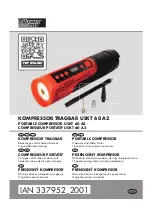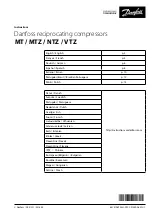
Section 2
DESCRIPTION
8
DO NOT remove caps, plugs, and/or other compo-
nents when compressor is running or pressur-
ized.
Stop compressor and relieve all internal pressure
before doing so.
Fluid is added to the sump via a capped fluid filler
opening, located on the tank to prevent overfilling of
the sump. A sight glass enables the operator to
visually monitor the sump fluid level.
2.6 CAPACITY CONTROL SYSTEM, FUNCTIONAL
DESCRIPTION
. The
purpose of the compressor control system is to reg-
ulate the compressor air intake to match the
amount of compressed air being utilized. At 0 to 10
percent air output, the control system will automat-
ically unload the compressor and reduce power
consumption. The unload sump pressure can be
set using the unload control regulator valve (150
psig/ 10.3 bar).
The
Control System
consists of an
inlet poppet
valve
,
startup solenoid valve
,
reference (equal-
izing) pressure regulator
,
blowdown solenoid
valve
,
pneumatic blowdown valve
,
control pres-
sure regulator
,
unload pressure regulator
,
sequencing solenoid valve
, and a
control line
filter
located prior to the controls.
The functional description of the Control System is
described below in five distinct phases of the com-
pressor operation. For explanation purposes, this
description will apply to compressors with an oper-
ating range of 350 to 360 psig (24.1 to 24.8 bar). A
compressor with any other pressure range would
operate in a similar manner except for the stated
pressures.
START MODE - TO 160 PSIG (11 BAR)
When the compressor start button is depressed,
the pressure will rise from 0 to 160 psig (0 to 11
bar). During this period, the control inlet solenoid is
closed, which keeps the inlet poppet valve closed.
The control pressure regulator is also closed at this
time. After the startup timer times out, the startup
solenoid valve changes state and the reference
pressure regulator controls the pressure signal to
the poppet valve at a maximum 60 psig (4 bar).
The inlet poppet valve opens allowing full airflow to
the compressor inlet and the discharge pressure
builds to approximately 160 psig (11 bar). No air is
supplied to the system service line during this
phase by the minimum pressure valve. When the
discharge pressure exceeds approximately 160
psig (11 bar), the minimum pressure valve may
start to open and allow air to flow to the system
service line.
NORMAL OPERATION MODE - 160 TO 350 PSIG
(11 TO 24.1 BAR)
When the sump pressure rises above 160 psig (11
bar), the minimum pressure valve opens and deliv-
ers compressed air to the system service line.
From this point on, a line air pressure transducer
continually monitors the air pressure. The control
pressure regulator valve remains closed during this
phase, keeping the inlet poppet valve wide open.
The blowdown solenoid valve also remains closed
during this phase. Flow will occur when the dis-
charge pressure is higher than the line pressure.
The check valve, which is built into the minimum
pressure valve, will prevent back flow into the com-
pressor.
MODULATING MODE - 350 TO 360 PSIG (24.1
TO 24.8 BAR)
If less than the rated capacity of compressed air is
being used, the system service line pressure will
rise above 350 psig (24.1 bar). The control pres-
sure regulator valve gradually opens applying air
pressure to the control side of the inlet poppet
valve, which modulates the position of the inlet pop-
pet valve. This reduces the amount of air entering
the compressor until it matches the amount of air
being utilized. The control system functions contin-
ually in this manner, between the limits of 350 to
360 psig (24.1 to 24.8 bar) in response to varying
demands from system service line. The control
pressure regulator valve has an orifice, which vents
a small amount of air to the atmosphere when the
control pressure regulator valve modulates the inlet
poppet valve.
UNLOAD MODE - EXCESS OF 360 PSIG (24.8
BAR)
As the required air is reduce, the discharge pres-
sure and line pressure rise above the 360 psig
(24.8 bar), the Supervisor II activates the unload
solenoid valve which in turn pressurizes the blow-
down valve. This opens the blowdown valve, which
allows discharge air to flow back to the compressor
inlet. Since the inlet poppet valve is fully closed,
the air pressure from the sump tank will be relieved
through the blowdown valve, which will reduce the
sump pressure. Some of the outgoing air will flow
directly into the compressor inlet to avoid cavitation
during this time of blowdown. As the sump pres-
sure drops, motor power consumption is also
Summary of Contents for LS20TS
Page 6: ......
Page 20: ...Section 2 DESCRIPTION 14 Figure 2 4A Control System Diagram Functional Components ...
Page 21: ...Section 2 DESCRIPTION 15 Figure 2 4B Control System Diagram START ...
Page 22: ...Section 2 DESCRIPTION 16 Figure 2 4C Control System Diagram MODULATION ...
Page 23: ...Section 2 DESCRIPTION 17 Figure 2 4D Control System Diagram FULL LOAD ...
Page 24: ...Section 2 DESCRIPTION 18 Figure 2 4E Control System Diagram UNLOAD ...
Page 40: ...NOTES 34 ...
Page 50: ...NOTES 44 ...
Page 53: ...NOTES 47 ...
Page 56: ...Section 8 ILLUSTRATIONS AND PARTS LIST 50 02250135 237R01 8 4 AIR INLET SYSTEM ...
Page 58: ...Section 8 ILLUSTRATIONS AND PARTS LIST 52 02250135 237R01 8 4 AIR INLET SYSTEM ...
Page 72: ...Section 8 ILLUSTRATIONS AND PARTS LIST 66 02250138 950R01 8 9 DISCHARGE SYSTEM ...
Page 74: ...Section 8 ILLUSTRATIONS AND PARTS LIST 68 02250138 950R01 8 9 DISCHARGE SYSTEM ...
Page 76: ...Section 8 ILLUSTRATIONS AND PARTS LIST 70 02250138 950R01 8 9 DISCHARGE SYSTEM ...
Page 78: ...Section 8 ILLUSTRATIONS AND PARTS LIST 72 02250139 578R00 8 10 CONTROL START SYSTEM ...
Page 80: ...Section 8 ILLUSTRATIONS AND PARTS LIST 74 02250139 578R00 8 10 CONTROL START SYSTEM ...
Page 82: ...Section 8 ILLUSTRATIONS AND PARTS LIST 76 02250137 724R02 8 11 CONTROL PANEL ...
Page 84: ...Section 8 ILLUSTRATIONS AND PARTS LIST 78 8 12 ENCLOSURE AND ENCLOSURE DECALS ...
Page 86: ...Section 8 ILLUSTRATIONS AND PARTS LIST 80 8 13 DECAL GROUP ...
Page 88: ...Section 8 ILLUSTRATIONS AND PARTS LIST 82 8 13 DECAL GROUP ...
Page 90: ...Section 8 ILLUSTRATIONS AND PARTS LIST 84 8 13 DECAL GROUP ...
Page 92: ...Section 8 ILLUSTRATIONS AND PARTS LIST 86 8 14 DECAL LOCATIONS OPEN WATER COOLED ...
Page 94: ...Section 8 ILLUSTRATIONS AND PARTS LIST 88 8 15 DECAL LOCATIONS CONTROL BOX ...
Page 97: ...NOTES 91 ...















































